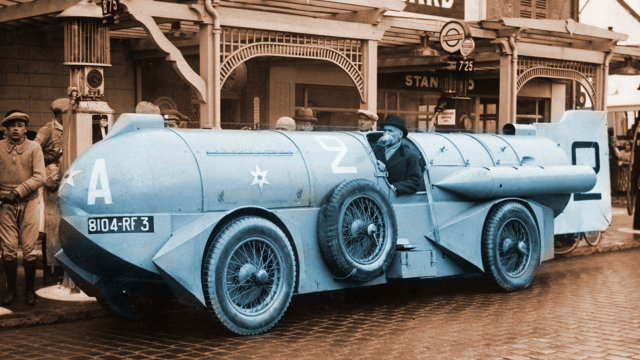When it comes to sheer madness, it’s hard to pick an automotive category more blessed with vehicular batshittery than Land Speed Record cars. They’ve been around since at least the later 1800s, and even in this category that includes rocket cars, cars made from jet fighters, and electric torpedoes you basically sit on top of, this incredible monster from a Frenchman named René Stapp stands out. But to this day it’s not really known if this man and his car represented a genuine, earnest attempt at the record, or a baffling hoax. Either way, it’s fascinating.
René Stapp was a racing driver and at least some sort of automotive designer and engineer, as his land speed record car was entirely his own design. It was built just outside of Paris, using what is said to have been a Voisin chassis.
It’s also suggested that the Voisin engine was left in the chassis to act as a starter motor for the planned main propulsion of the car, a trio of nine-cylinder radial engines from Bristol Jupiter aeroplanes.
I guess just having three radial engines powering a car must have seemed too pedestrian for old René, because he claimed that those three engines would have all their 27 pistons removed, and would be operating as gasoline turbines, somehow. According to historian Dale LaFollete,
The engines would make 800 horsepower each and would transmit their power to all four wheels by an electric transmission. He estimated that the car could attain maximum speed of 372 mph (600 kph)…
I’m not really clear how an “electric transmission” would send 800 HP to the wheels without using an 800 HP motor?
It seems that Stapp may not have been entirely clear, either, since there’s no actual evidence that the three radial engines were ever installed in the car. That’s not to say that the car didn’t run; it absolutely did, as you can see in some period footage, but it was likely just using the original Voisin engine.
That footage of the car driving is interesting for a number of reasons: first, just look at that damn thing, and second, note how the driver, Mssr. Stapp himself, is piloting it: standing up.
There was no provision to actually sit in the car, so the driver just stood in that little socket, and there appears to have been no windscreen or anything like that. I guess the thinking was the driver would have goggles?
For the little trip into the streets of Paris that you can see in that old footage, it’s funny to note the spare tire and rear-view mirror slapped onto that thing for the trip.
The sheer scale of the car is remarkable, and could easily have held those three radial turbine whatevers, I’d expect. The rear cone was perforated with a lot of exhaust nozzles of some sort, and there’s some interesting early streamlining attempts going on here: the overall torpedo shape, the tapered, pointed fenders leading and behind each wheel, and that gigantic rear fin, perhaps to provide some rudder-control while at speed?
Stapp’s plan was to take the beast to Daytona Beach, where he’d try to beat the then-current speed record of over 253 mph (407 km/h), set by Malcom Campbell in the Campbell-Napier-Railton Blue Bird.
Before shipping that thing all the way across the ocean, though, Stapp decided to test it on a French beach called La Baule that was nice and long and used extensively as a raceway in that era.
While getting ready to do a speed run on the beach, Stapp’s creation caught fire and burned to the, sand, I guess, and while René himself was able to get clear, the car was destroyed.
The Italian magazine La Tribuna Illustrata’s May 8, 1932 issue covered the fire, and suggested that Stapp fractured his knee, and his mechanic was banged up a bit.
The question remains, though: was this disaster staged? Did Stapp rig the machine to burn, somehow, or was this a genuine accident? If the car had none of its three turbines installed, there wouldn’t have been much to test on the beach. Was the fire a cover for the fact that the car was nowhere near what it claimed to be?
We really have no idea. Stapp sort of disappeared after all this, and while it’s possible the car had the strange and advanced drivetrain he suggested, there’s no proof, either—no patents or photographs or blueprints of any kind.
If it was a hoax, it’s also confusing as to the goal—just a publicity stunt? For what, exactly, though? His engineering abilities? His daring? What was the goal, here?
I’m just not sure. And, after 88 years, I don’t really think we’re any closer to an answer.
Still, it’s a gloriously bonkers thing, isn’t it?
